
In India, the navel — the umbilicus or belly button — is called Nabhi. The Sanskrit word Nabhi translates as “wheel,” “center” or “navel.” The Nabhi is also called Tundi, which could mean either “navel” or “abdomen,” depending on the context wherein the word is used.

The Nabhi and the immediate area around it play an important role in Yoga, in Ayurveda, in abdominal massages, and in general in a range of bodywork modalities that originate in Asian Traditional Medicine systems.
This makes sense, because we just need to think about how a baby develops in the uterus; the connection with the mother is through the umbilical cord (attaching the unborn baby to the placenta in the mother’s womb), which supplies blood, nutrition, oxygen, and according to Asian concepts — Prana (Vital Life Energy).
How this has influenced Vital Life Energy theories in India can be seen with, for instance, the concept of Kanda (or Kandasthana, a circular area around the navel), which is said to be a prime location where Prana enters the physical body, and the starting point of all Nadis (Prana Energy Channels).
Subsequently, “opening and unblocking” points in the Kanda area is important for Prana distribution along the Nadis. Much work is done to soften and release the Kanda, an area often rather contracted and tensed, with typically lots of muscle knots, tangles and adhesions in muscles and connective tissues.

But, also the shape of the navel is important and can provide information about physical, mental and emotional health. For instance, “pulls” of the navel in a certain direction can give indications of what underlying problems may exist in the abdominal or other areas of the body.
In India, it’s furthermore thought that the area just above the Nabhi is the location of the Solar Plexus Chakra, which is also called the Manipura Chakra. This particular Chakra, part of the group of seven principal Chakras, is thought to guard metabolism and digestion, the process where food is converted into energy and action.
On a more spiritual, energetic level the Manipura Chakra represents our action, will, vitality, our strength to change and transform, that is, our sense of personal power.















